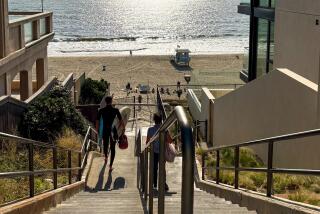Bird Watchers Flock Together for Appointed Rounds
- Share via
Sunday morning my wife and I got up at 6 o’clock for the annual Jack and Denny Smith bird walk at Descanso Gardens.
It was raining. My wife said, “You think they’d have a bird walk in the rain?”
She telephoned Karen Johnson, who leads the walk, and asked if she was going on with it. Johnson said she would be there, even if she was the only one.
When we left the house the rain had stopped. The air was damp and cold. Driving up Linda Vista Drive and then Berkshire Avenue, through La Canada Flintridge we felt that it was the best of all possible worlds.
There were more joggers than cars in the streets. Along Berkshire, mansions of various architectural styles sat back behind lawns, oaks and sycamores. BMWs and Mercedes-Benzes stood in curved driveways. Newspapers lay where they had been tossed.
Only about 25 birders were gathered inside the gate at Descanso for the walk. They were a motley bunch, in warm coats and caps. Most carried binoculars and bird books. Johnson made a brief talk and called on me. I said birders were an odd lot, but not so odd as to want to hear a talk on a cold and rainy morning.
The bird walk is not as old an institution as the Tournament of Roses, but it has been going on more years than anyone, including Johnson, can remember. It was started after I sighted a common grackle in my back yard, an event so rare (in fact unprecedented) that it made me something of a celebrity in birding circles. On some past Sundays more than 200 birders had attended.
We plodded off over the damp leafy paths through groves of oaks and sycamores, Johnson leading. “Varied thrush!” she suddenly called out. We were galvanized. “It’s very rare here,” she said. “Maybe one a year. It’s a good omen.”
Energized by this first sighting we pushed on, a hardy little band. A tall thin man with a fine gray beard told me he was with the Jet Propulsion Lab, and that he had traveled over the hemisphere looking for hummingbirds. “I’ve seen more than 130 species,” he said. I was among experts.
Birds began appearing almost too rapidly to identify. “We’ve got a mockingbird on the right,” called Johnson. “There’s a robin in the oak tree,” a woman shouted. “Ruby-crowned kinglet!” . . . “Black phoebe in the rosebush!”
Johnson pointed to a flock of gray birds circling above the trees. “Cedar waxwings,” she said. I knew cedar waxwings. They used to flock in our cotoneaster bush in the front yard and get drunk on fermented berries. A very human bird.
Various species began to pop up. Fat California quail waddled across the path. Yellow-rumped warblers. Someone spied a hermit thrush. Anna’s hummingbirds hovered in a great oak. A red-tailed hawk. Cooper’s hawk.
My wife said there seemed to be more birds than ever before. I said there were no more birds; it was just that, there being fewer people, instead of tailing off at the end of the group to socialize, we were actually bird-watching.
A large bird with a long neck soared overhead. Someone identified it, correctly, according to Johnson, as a cormorant. Strange place for a sea bird, I thought.
From the bird station above the pond we looked down on numerous water birds, including a school of ring-tail ducks that were just sitting there. They looked like sitting ducks.
“Look at the squirrels,” my wife said, pointing to three fat squirrels playing around a gnarled oak tree. “We don’t report squirrels,” I told her. “Only birds.”
Finally the perennial great blue heron showed up, flapping low over the pond and taking refuge in a bush. The heron had never disappointed us, year after year. Johnson said it was probably the same bird.
Someone spotted a woodpecker. “See his red head,” said Johnson. A woman came up behind me. She said she was Corrine Hatfield, a Glendale high school teacher. “What did I miss?” she asked me. I said, “A redheaded woodpecker.”
“No such thing,” she said positively. “It was probably a Nutall’s. Redheaded woodpeckers are in the East.” (That’s what they said about the grackle.)
“It had a red head,” I said, “and it was a woodpecker.”
“Bosh,” said Hatfield, and opened her book to woodpeckers. “See,” she said. “This is a Nutall’s woodpecker. This is a redheaded woodpecker.”
“Scrub jay,” Johnson cried. Actually, I have always held that scrub jays should be blue jays, because they’re jays and they’re blue. This bird is far too beautiful to be called a scrub. But in this notion I am ridiculed by the erudite Hank Childs, birdman of Upland. He says the blue jay is an altogether different bird.
I suppose I have a lot to learn about birds. But I do know a grackle when I see one.
More to Read
Sign up for The Wild
We’ll help you find the best places to hike, bike and run, as well as the perfect silent spots for meditation and yoga.
You may occasionally receive promotional content from the Los Angeles Times.






